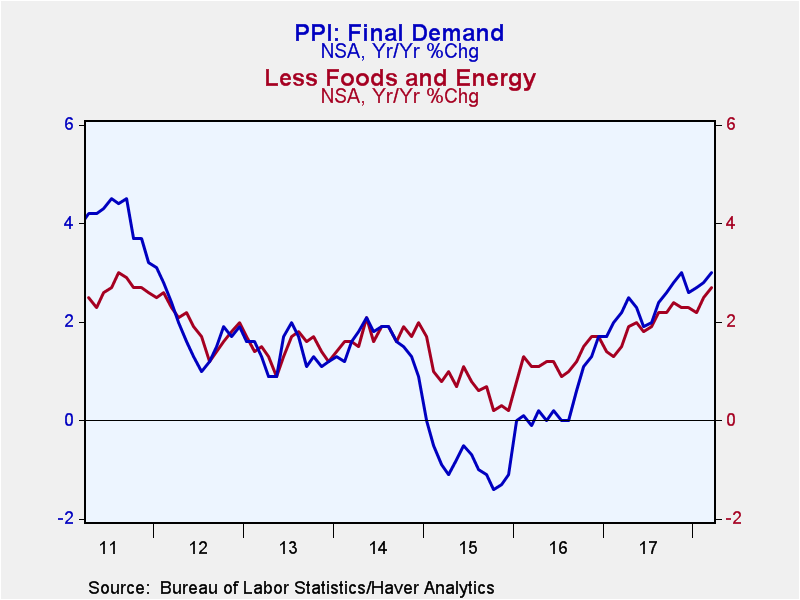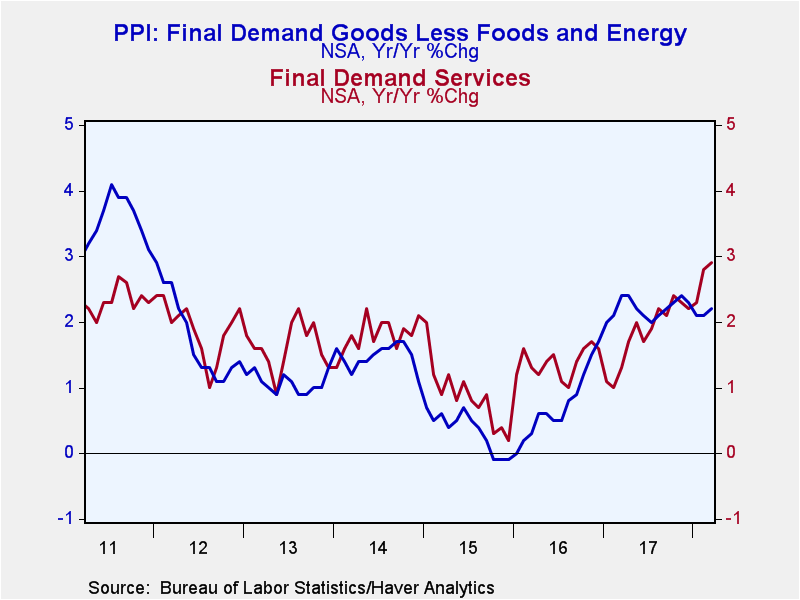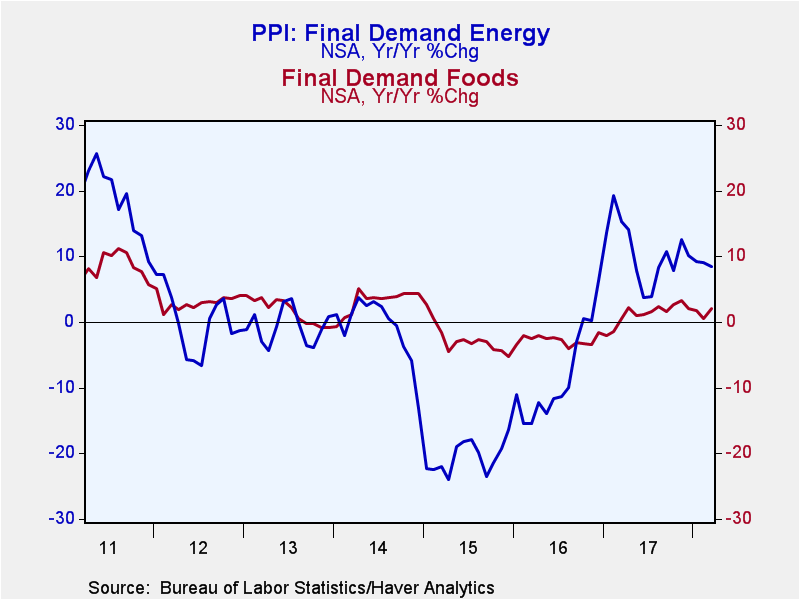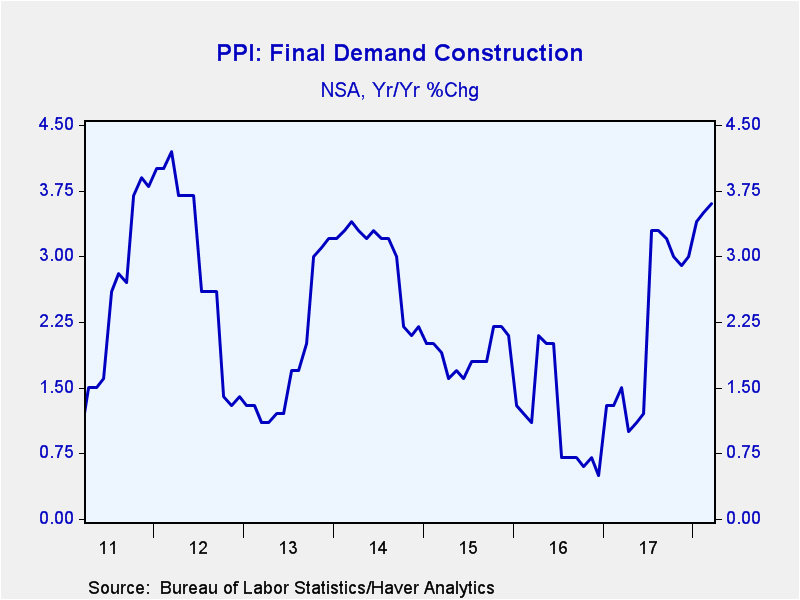 Global| Apr 10 2018
Global| Apr 10 2018U.S. Producer Price Gains Accelerate
by:Tom Moeller
|in:Economy in Brief
Summary
The headline Final Demand Producer Price Index using new methodology increased 0.3% in March following a 0.2% rise in February. Twelve-month growth rose to 3.0%. A 0.2% March rise had been expected in the Action Economics Forecast [...]
The headline Final Demand Producer Price Index using new methodology increased 0.3% in March following a 0.2% rise in February. Twelve-month growth rose to 3.0%. A 0.2% March rise had been expected in the Action Economics Forecast Survey. The PPI excluding food & energy increased 0.3% versus an expected 0.2% rise. Year-on-year growth accelerated to 2.7%, the fastest pace since late-2011. An updated measure of core producer price inflation (the overall index excluding food, energy and trade services) strengthened 0.4% for the third consecutive month. Prices for this index rose 2.9% y/y, the strongest reading since the series began in August 2013.
Using the old methodology for the Producer Price Index, prices rose 0.2% (2.9% y/y). Excluding food & energy, the index increased 0.2% (1.9% y/y) following no change.
Final demand goods prices rose 0.3% (3.2% y/y) after a 0.1% dip. The goods price index excluding food & energy gained 0.3% (2.2% y/y) after three consecutive 0.2% increases.
Food prices strengthened 2.2% (2.0 y/y) in March, after three straight months of decline. The increase was the strongest since April 2014. It reflected a 4.1% increase (8.2% y/y) in beef & veal prices as well as a 2.0% surge (-3.4% y/y) in pork prices. Fresh fruit costs fell 1.7% (-2.5% y/y) following a 2.9% decline. Energy prices fell 2.1% (+8.5% y/y) as home heating oil priced dropped 10.1% (+14.8% y/y) and gasoline prices fell 3.7% (+15.0% y/y). Natural gas prices held steady (3.0% y/y) and electric power costs declined 0.8% (+1.4% y/y).
Nondurable consumer goods prices less food & energy increased 0.2% (3.7% y/y) after a 0.2% rise. Durable consumer goods prices rebounded 0.4% (1.1% y/y) following a 0.3% drop. Passenger car prices gained 0.2% (-1.4% y/y) and light truck prices rose 0.7% (0.7% y/y). Private capital equipment prices strengthened 0.3% (0.9% y/y) after remaining unchanged in February. It was the strongest monthly increase since January 2015. Manufacturing capital equipment rose 0.2% (1.6% y/y) after a 0.3% rise, while nonmanufacturing capital equipment improved 0.3% (0.8% y/y), the strongest rise since April 2015.
Final demand for services prices increased 0.3% (2.9% y/y) for the third consecutive month. Prices less trade, transportation & warehousing gained 0.3% causing y/y growth to strengthen to 3.3%, up from 2.2% last year. It was the strongest reading since the series began in November 2009. Trade services costs increased 0.2% (2.0% y/y) while transportation and warehousing prices rose 0.6% (5.0% y/y).
Final demand construction prices improved 0.2% (3.6% y/y) with private capital investment construction prices growing 0.3% (3.7% y/y) and government costs easing 0.1% (+3.4% y/y).
Prices for intermediate demand goods declined 0.3% (+4.6% y/y) following two months of 0.7% increase.
The PPI data are contained in Haver's USECON database with further detail in PPI and PPIR. West Texas Intermediate Crude Oil prices are found in the USECON database while the expectations figures are available in the AS1REPNA database.
The Budget and Economic Outlook: 2018 to 2028 from the Congressional Budget Office is available here.
| Producer Price Index (SA, %, New Methodology) | Mar | Feb | Jan | Mar Y/Y | 2017 | 2016 | 2015 |
|---|---|---|---|---|---|---|---|
| Final Demand | 0.3 | 0.2 | 0.4 | 3.0 | 2.3 | 0.4 | -0.9 |
| Excluding Food & Energy | 0.3 | 0.2 | 0.4 | 2.7 | 1.9 | 1.2 | 0.8 |
| Excluding Food, Energy & Trade Services | 0.4 | 0.4 | 0.4 | 2.9 | 2.1 | 1.2 | 0.6 |
| Goods | 0.3 | -0.1 | 0.7 | 3.2 | 3.3 | -1.4 | -4.3 |
| Foods | 2.2 | -0.4 | -0.2 | 2.0 | 1.2 | -2.8 | -2.6 |
| Energy | -2.1 | -0.5 | 3.4 | 8.5 | 10.4 | -8.4 | -20.6 |
| Goods Excluding Food & Energy | 0.3 | 0.2 | 0.2 | 2.2 | 2.2 | 0.7 | 0.4 |
| Services | 0.3 | 0.3 | 0.3 | 2.9 | 1.8 | 1.4 | 0.9 |
| Trade Services | 0.2 | -0.2 | 0.3 | 2.0 | 1.5 | 1.3 | 1.3 |
| Construction | 0.2 | 0.1 | 0.8 | 3.6 | 2.2 | 1.1 | 1.9 |
| Intermediate Demand - Processed Goods | -0.3 | 0.7 | 0.7 | 4.6 | 4.7 | -3.1 | -6.9 |
Tom Moeller
AuthorMore in Author Profile »Prior to joining Haver Analytics in 2000, Mr. Moeller worked as the Economist at Chancellor Capital Management from 1985 to 1999. There, he developed comprehensive economic forecasts and interpreted economic data for equity and fixed income portfolio managers. Also at Chancellor, Mr. Moeller worked as an equity analyst and was responsible for researching and rating companies in the economically sensitive automobile and housing industries for investment in Chancellor’s equity portfolio. Prior to joining Chancellor, Mr. Moeller was an Economist at Citibank from 1979 to 1984. He also analyzed pricing behavior in the metals industry for the Council on Wage and Price Stability in Washington, D.C. In 1999, Mr. Moeller received the award for most accurate forecast from the Forecasters' Club of New York. From 1990 to 1992 he was President of the New York Association for Business Economists. Mr. Moeller earned an M.B.A. in Finance from Fordham University, where he graduated in 1987. He holds a Bachelor of Arts in Economics from George Washington University.










